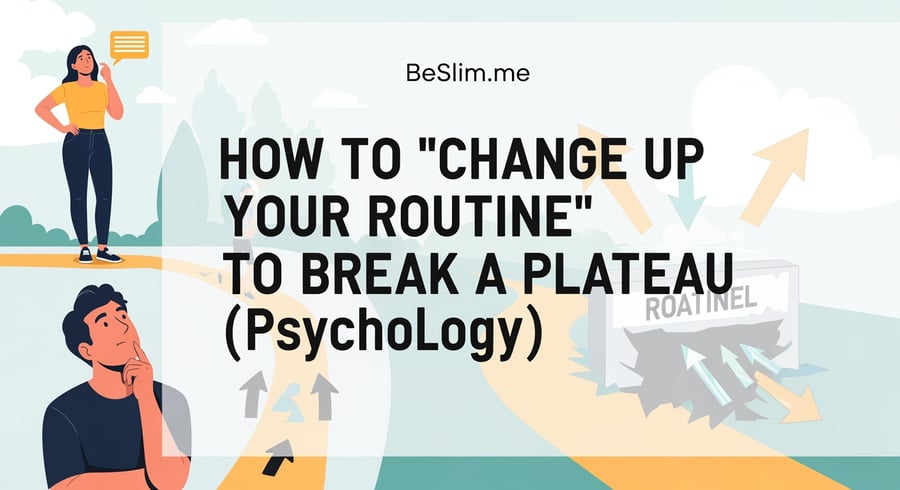Hello, I'm Master Kim, your Behavioral Psychologist and Solution Consultant at BeSlim.me. Hitting a weight loss plateau can feel incredibly frustrating—like you're putting in the effort but the scale just won't budge. You're not alone in this; it's a completely normal part of the journey for so many people. Whether it's due to metabolic adaptations or deeply ingrained habits, the psychological toll can make it even harder to push through. In this Q&A guide, we'll explore the mindset and behavioral strategies to help you change up your routine effectively. Drawing from behavioral science, I'll explain the "why" behind plateaus, offer actionable steps, and empower you to break free sustainably.
Why Do Plateaus Happen, and Why Is Changing Your Routine So Hard?
Q: What exactly is a weight loss plateau from a psychological and behavioral perspective?
A: A plateau occurs when your body and mind adapt to your current routine, leading to stalled progress. Psychologically, this often stems from habit loops—automatic patterns of cues, routines, and rewards that make change feel daunting. For instance, your brain might be wired to expect a post-workout snack as a reward, and disrupting that can trigger resistance. Behaviorally, willpower depletion plays a role; as explained in ego depletion theory, our self-control is like a muscle that tires out, making it harder to introduce new habits without strategic planning.
On the hormonal side, chronic stress can elevate cortisol levels, which promotes fat storage and emotional eating, further entrenching routines. This isn't just "laziness"—it's your brain's way of conserving energy in a familiar environment. According to research, habit formation relies on the basal ganglia in the brain, which automates behaviors to reduce cognitive load, making plateaus a natural defense mechanism against constant change.
Q: How does stress contribute to getting stuck in a routine during a plateau?
A: Stress acts as a silent saboteur by linking to the stress-cortisol cycle. When you're stressed—perhaps from work or life demands—cortisol spikes, increasing cravings for comfort foods and reducing motivation for exercise. This creates a feedback loop where your routine becomes a coping mechanism, even if it's not serving your goals. Behaviorally, this ties into emotional regulation: people often stick to routines to avoid the discomfort of novelty, which can feel overwhelming during high-stress periods.
Scientifically, studies show that elevated cortisol from chronic stress can impair prefrontal cortex function, making habit change more difficult. It's not about lacking discipline; it's your body's evolutionary response to perceived threats, prioritizing survival over optimization.
Q: Why do some people resist changing their routines, even when they know it's needed?
A: Resistance often comes from cognitive dissonance and loss aversion—psychological principles where your mind clings to the familiar to avoid the "loss" of comfort or predictability. For example, swapping your evening walk for a new HIIT session might feel like losing a relaxing ritual. Willpower depletion exacerbates this; after a day of decisions, your mental reserves are low, leading to procrastination.
From a behavioral science view, this is rooted in how habits form through repetition, creating neural pathways that favor the status quo. Research indicates that breaking habits requires disrupting the cue-routine-reward cycle, but initial efforts can increase stress temporarily. Understanding this helps normalize the struggle—it's not a personal failure, but a brain wired for efficiency.
Actionable Solutions: Strategies to Change Up Your Routine
Here, we'll dive into practical, step-by-step strategies grounded in behavioral psychology. Each one focuses on sustainable changes, with examples to make them relatable. Remember, the key is starting small to build momentum without overwhelming your willpower.
Strategy 1: Identify and Disrupt Habit Loops
To break a plateau, first map out your current routines using the habit loop model (cue, routine, reward) from behavioral science. This prevents autopilot behaviors that keep you stuck.
- Track your triggers: For one week, journal daily cues—like time of day or emotions—that prompt your routine (e.g., snacking after dinner because you're bored).
- Modify the routine gradually: Replace one element at a time. If your cue is evening fatigue leading to skipping workouts, insert a 5-minute stretch instead of a full session.
- Reinforce with rewards: Pair the new routine with an immediate, non-food reward, like listening to a favorite podcast.
Example Scenario: Sarah noticed her post-work cue (arriving home) led to couch-scrolling instead of meal prep. She disrupted it by placing workout clothes by the door as a visual cue, rewarding herself with a relaxing tea afterward. Within two weeks, her energy levels improved, breaking her plateau.
Strategy 2: Incorporate Novelty to Combat Adaptation
Your body and mind adapt to repetition, so introducing variety reignites progress. This leverages neuroplasticity—the brain's ability to rewire through new experiences—without depleting willpower.
- Assess your current routine: List your weekly activities (e.g., same gym classes) and rate their staleness on a scale of 1-10.
- Add one novel element weekly: Swap in something new, like trying yoga instead of running, or experimenting with a new recipe.
- Monitor and adjust: After a week, note changes in motivation or results, tweaking as needed for sustainability.
Example Scenario: Mike's weight stalled after months of the same cardio routine. He introduced novelty by joining a group hiking class once a week, which not only varied his exercise but also added social rewards. This small change boosted his metabolism and motivation, leading to a 5-pound drop in a month.
Strategy 3: Manage Stress to Build Change Resilience
Address the stress-cortisol link head-on, as high stress erodes your ability to adapt routines. This strategy uses mindfulness techniques to preserve willpower.
- Daily stress check-in: Spend 2 minutes morning and evening rating your stress (1-10) and noting triggers.
- Incorporate micro-relaxation: Before changing a routine, do a 1-minute breathing exercise (e.g., 4-7-8 breathing: inhale for 4, hold for 7, exhale for 8).
- Link to routines: Tie stress management to your plateau-breaking actions, like meditating before a new workout to reduce resistance.
Example Scenario: Lisa's job stress made evening routines impossible to change, leading to emotional eating. By starting with micro-relaxation before meal prep, she lowered cortisol, making it easier to swap snacks for veggies. Over time, this built resilience, helping her lose the plateau weight steadily.
Strategy 4: Use Implementation Intentions for Sustainable Shifts
This evidence-based technique from psychology turns vague goals into "if-then" plans, making routine changes automatic and less reliant on willpower.
- Define specific intentions: Create statements like, "If I feel the urge to skip my walk (cue), then I'll put on my shoes and step outside for 2 minutes."
- Practice mentally: Visualize the scenario 3-5 times daily to strengthen neural pathways.
- Review weekly: Adjust intentions based on what worked, ensuring they're realistic for long-term adherence.
Example Scenario: Tom's plateau stemmed from inconsistent mornings. He set an intention: "If my alarm goes off, then I'll drink a glass of water and do 10 jumping jacks." This simple plan disrupted his snooze habit, leading to more active days and renewed progress.
Strategy 5: Build Accountability Through Social Support
Leverage the power of social psychology—where external accountability boosts commitment—to make routine changes stick without isolation.
- Choose an accountability partner: Share your routine change goal with a friend or join an online community like BeSlim.me forums.
- Set check-ins: Schedule weekly updates, sharing wins and setbacks to normalize the process.
- Celebrate collectively: Reward milestones together, like a virtual high-five or group challenge, to reinforce positive behaviors.
Example Scenario: Emma felt alone in her plateau until she partnered with a coworker for routine swaps (e.g., walking lunches). Their mutual encouragement helped her stick to changes, resulting in increased energy and weight loss after weeks of stagnation.
Wrapping Up: You Have the Power to Break Through
Remember, breaking a plateau by changing your routine isn't about drastic overhauls—it's about compassionate, science-backed steps that honor your brain's natural wiring. You've already shown incredible resilience by seeking this guidance, and with persistence, these strategies will reignite your progress. Change is possible, one small shift at a time. If you need personalized support, reach out at BeSlim.me—I'm here to help you thrive.
References
Medical Disclaimer
The content on this website is for informational and educational purposes only. It is not intended as medical advice and should not be relied upon as a substitute for consultations with qualified healthcare professionals who are familiar with your individual medical needs. Always seek the advice of your physician or other qualified healthcare provider with any questions you may have regarding a medical condition. Never disregard professional medical advice or delay in seeking it because of something you have read on this website.





Comments (0)
No comments yet. Be the first to comment!